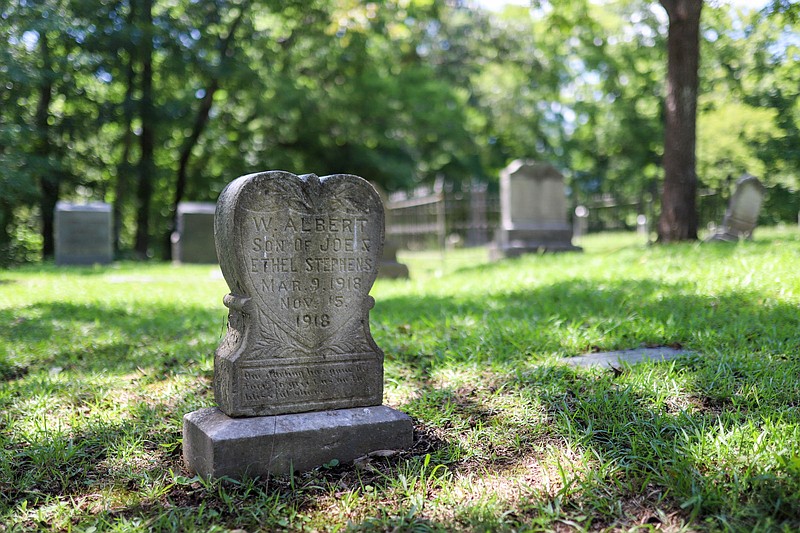The city of Red Bank has two abandoned cemeteries on city-owned property, but until recently, city officials were only aware of one.
Red Bank Cemetery is tucked away in a neighborhood near Morrison Springs Road. The 1-acre cemetery is no longer active aside from several plots purchased long ago, and city staff continues to mow the grass but provides no other maintenance, City Manager Martin Granum said.
The oldest tombstone Granum found dates back to 1890, and the most recent burial was in 1991.
Granum, who moved to Red Bank in October after he was hired as city manager, said he first heard about the other cemetery - a forgotten potter's field on Stringer's Ridge - while on a run with a friend. When he learned it was on city property, he started planning to create a committee to help guide the city in appropriately honoring the people buried there.
Coincidentally, the city was contacted around the same time by Donivan Brown, who is researching the history of the cemetery with support from the Trust for Public Land.
Completely overgrown, the potter's field has no headstones. The only remaining physical evidence of its existence are numbered cast iron stakes found on the property, which is in a steep gully between the Hill Pointe and North Point Ridge neighborhoods.
The potter's field had been lost to memory, at least among those currently employed by the city, Granum said.
He said the city hopes to incorporate the outcome of Brown's work into a sustainable level of stewardship of the cemetery grounds.
Brown learned of the existence of a potter's field in Red Bank while serving as chair of the Ed Johnson Project, which created a memorial to Walnut Street Bridge lynching victim Ed Johnson. The committee working on the project was told that the first Black man lynched on the bridge, Alfred Blount, was buried in a potter's field operated by Hamilton County in what is now Red Bank, though the exact location was unknown.
About a year later, Brown was contacted by the Trust for Public Land, and he is now the lead community consultant on the organization's project focused on the potter's field, which the Trust for Public Land is calling "the field."
Noel Durant, Tennessee director of the Trust for Public Land, said the organization became involved when he was approached by Michael Hitt, a historian from North Georgia who was looking for the burial site of George Chamblee, the namesake of Chamblee, Georgia.
"He traced Mr. George Chamblee to the municipal cemetery, which is the field," Durant said.
But when Hitt went searching for the field's location, he couldn't find the cemetery or anyone who knew about it. He approached the Trust for Public Land because of the organization's work on Stringer's Ridge, which was known to be the general location of the cemetery.
Durant said the organization had no previous knowledge of the cemetery, thought to be Hamilton County's second potter's field, where county residents who couldn't afford burial costs were interred from 1890-1912.
"As [Brown] started looking into the history of the cemetery, it became really clear that it was a place that had a really difficult past and was a place that was in need of some reconciliation and healing," Durant said. "Over three-quarters of those who are interred there are African American, and some of the stories of those who are buried there are really hard. The treatment of their bodies after death was really hard as well."
Brown said much was written at the time about the mismanagement of the cemetery.
"It was known that people were buried with limited coverings of soil, body parts were exposed, including children that were exposed to nature," Brown said. "Wild animals would essentially utilize it as a feeding ground. There was also cadaver theft of those buried in the cemetery."
The Trust for Public Land has a Black history and culture program with a goal of preserving areas important to the Black experience in America, Durant said. The organization is supporting Brown's initial research and engagement with the community, which along with Red Bank elected officials has expressed strong interest in the project so far, he said.
"The city of Red Bank looks very different demographically from those who are buried in the field, but we heard time and time again that we need to address our past and we need to address these past wrongs," Durant said.
While hosting their annual conference in Chattanooga next week, members of the Tennessee chapter of the American Institute of Architects are participating in a community design effort at White Oak Park on Aug. 10 at 6 p.m.
The joint effort with the African American Cemetery Preservation Fund will focus on the White Oak Connector Trail, another Trust for Public Land project that connects Red Bank's White Oak Park to Chattanooga's Stringers Ridge Park, as well as the cemetery on the embankment next to the trail and how the design of each can inform the other, Durant said.
Last week, the Red Bank City Commission voted to establish the Red Bank Cemetery Advisory Board, which will have up to 10 members who will also be tasked with guiding the sustainment of both cemeteries.
Contact Emily Crisman at ecrisman@timesfreepress.com or 423-757-6508.
